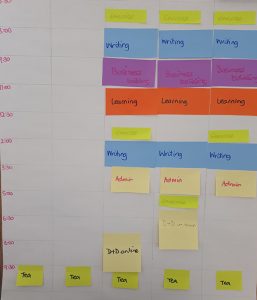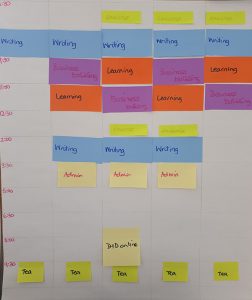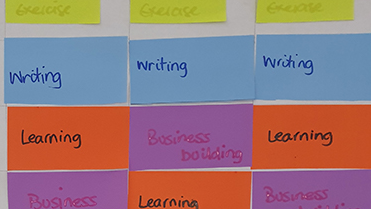I’m working at home at the moment, focusing on writing and re-establishing my freelance/consulting business. Working at home, on self-directed tasks, takes deliberate planning and discipline – otherwise I’m likely to clean the house and talk to the kittens all day.
In the past I’ve always squeezed this kind of work around something more structured like client work or conference organising, so this is the first time I’ve had to come up with a strong method to keep focused and productive.
I already have two very strong practices that work for me:
- All of my ‘todos’, including every random idea that I might want to do one day, are in Todoist, using Getting Things Done. They are organised into projects (or single actions for solo tasks). Things that I can do (next actions) are tagged with their context. At the beginning of the week I think about goals for the week and mark priority 1 and 2 tasks. I’m comfortable with this method, and it works for me as long as I actually do that weekly planning.
- I use the pomodoro technique every time I sit down (working for 25 minutes on a task, then 5 minute break). Toggl both does my time tracking and pomodoro management

Time blocking
Time blocking is an organisation method where you block out your whole calendar into blocks of time.

Instead of deciding what to do next ‘on-the-fly’, or deciding based on some input (email, direct message), you decide ahead of time what is important and where you want to focus, and make it visual.
My focus areas at the moment are writing, learning, business development and admin.
I know that I can comfortably work for about 90 minutes on a single topic – 3 pomodoros. I’m better at focused tasks in the morning (and the house is quieter). By lunch I’ve run out of juice and, without preparation, will abandon a plan and do easy work until late afternoon (which really is a waste of time).
So I set up my first time block with 90 minute blocks and a long break over lunch to go for a walk, get groceries, sit in the hammock.
Week 1

I set everything up on a Tuesday, so had 3 days to test out the new approach. I was energised about trying something new and the week worked reasonably well.
On day 2, I hit the ‘business development’ block, saw something in my list that I’d been putting off for a while (email a friend about redoing my business brand), thought ‘oh, I’ll do that next week’. But no, it was in my list, at the top, marked as P1. So I did it, and I was glad I did as we got started on it straight away.
I did make a lot of progress on writing, and learned that doing it first thing, before opening anything else on my computer, is a GOOD THING.
Week 2

Week 2 I set up the time block in the same way. Writing in the morning, shuffled around the learning and business development to see what was best for energy, writing and admin in the afternoon. I took Monday mostly off as my neck was painful.
Week 2 just didn’t work out. Every day I started out well and wrote for an hour and a half. Then I opened the Illustrator course I’m doing (learning) and would just continue with that most of the day.
It wasn’t that I was super-excited about the course. I was tired, and it was easy work. I fell back into old habits and did what was easy rather than what I’d planned.
Looking at it late in the week and I realised I felt like the whole thing was fake and I was following a fake structure for no real reason. I felt like I was forcing myself into a structure just for structure’s sake.
The thing I hadn’t done well was really think about what I wanted to achieve that week. I had written a list of goals at the beginning of the week, but they were a bit routine and tokenistic. I hadn’t really thought about what mattered most, what I wanted to achieve, and why I was doing it. So when faced with tired, I abandoned my fake construct.
Week 3 (this week)
This week I spent more time planning on Tuesday morning (we had a holiday Monday). I went through my Getting Things Done routine properly – cleaning out my inbox, setting proper priorities and marking everything up properly. This week I feel like I am working towards something for a reason, not just following the dancing blocks of colour.

Tuesday was good – it was mostly an administrative day as I gave a talk at a client and then worked in town at the library. It was a little harder to focus on the big blocks, so I took down some smaller mountains instead.
Wednesday started well. I knocked over my first writing task easily and looked at what was my next… This post. No, surely I should do some research for my book. No – I said this post was P1. So it’s P1.
And I got it finished with 5 minutes to spare!
(though I didn’t hit ‘publish’ immediately – I had to add in the photos and illustrations. That took today’s writing block. The other thing this approach forces me to do is actually just finish something instead of fussing. I have 4 minutes to spare, and I don’t want to do this tomorrow, so I’m hitting publish now!)

